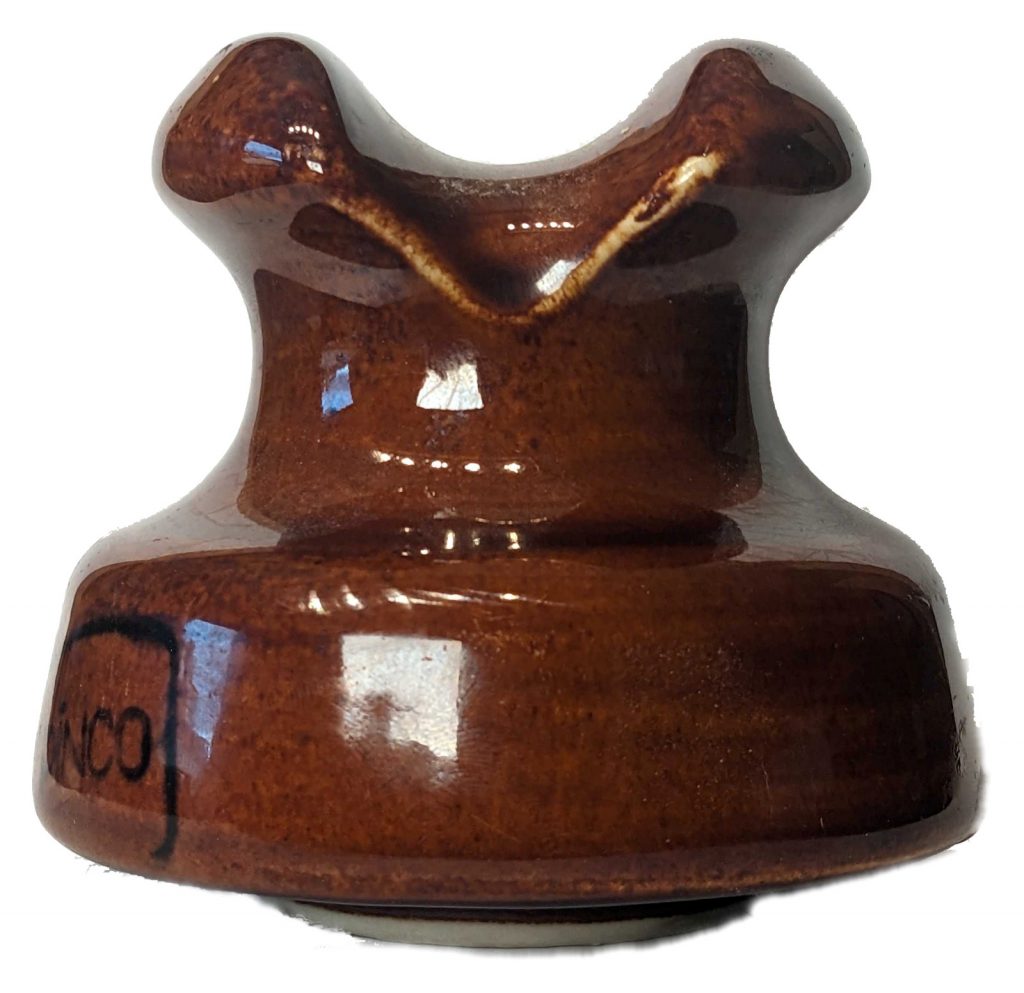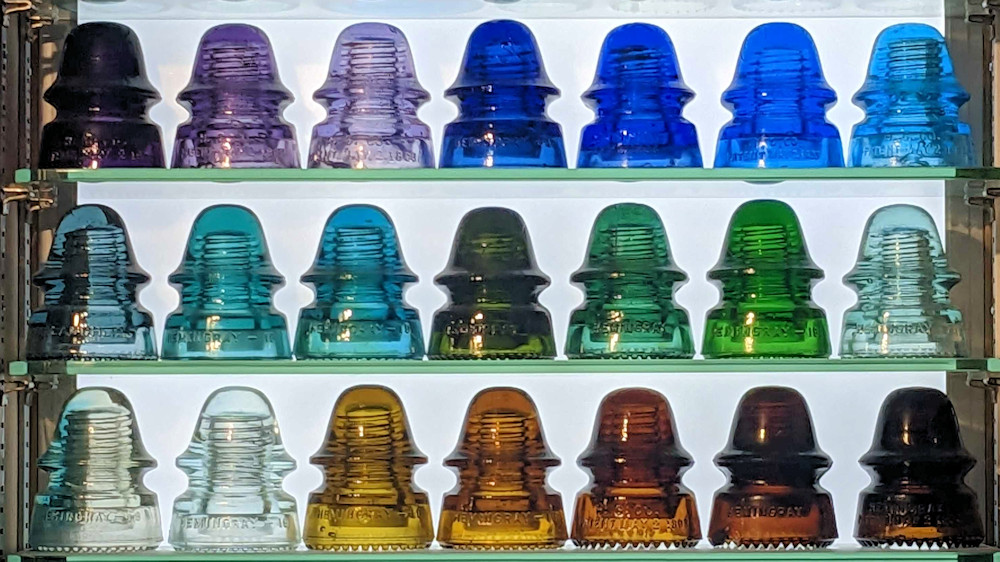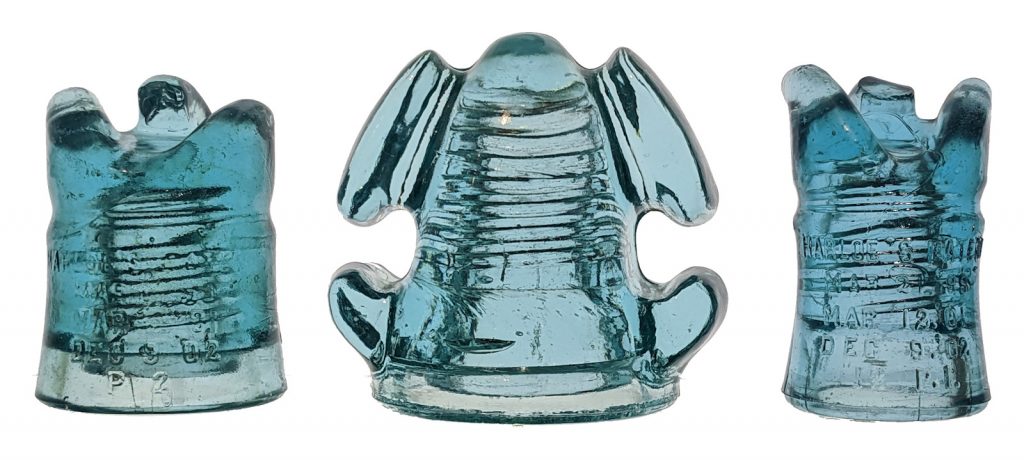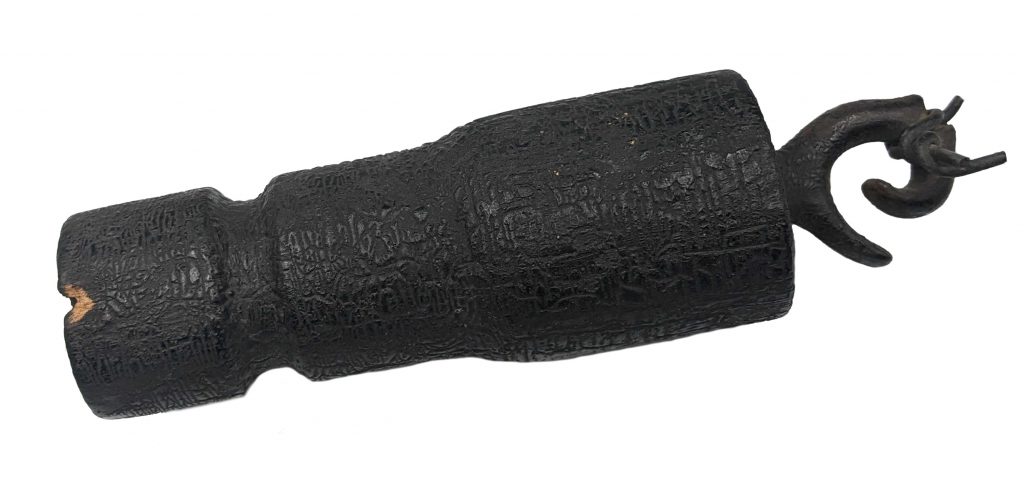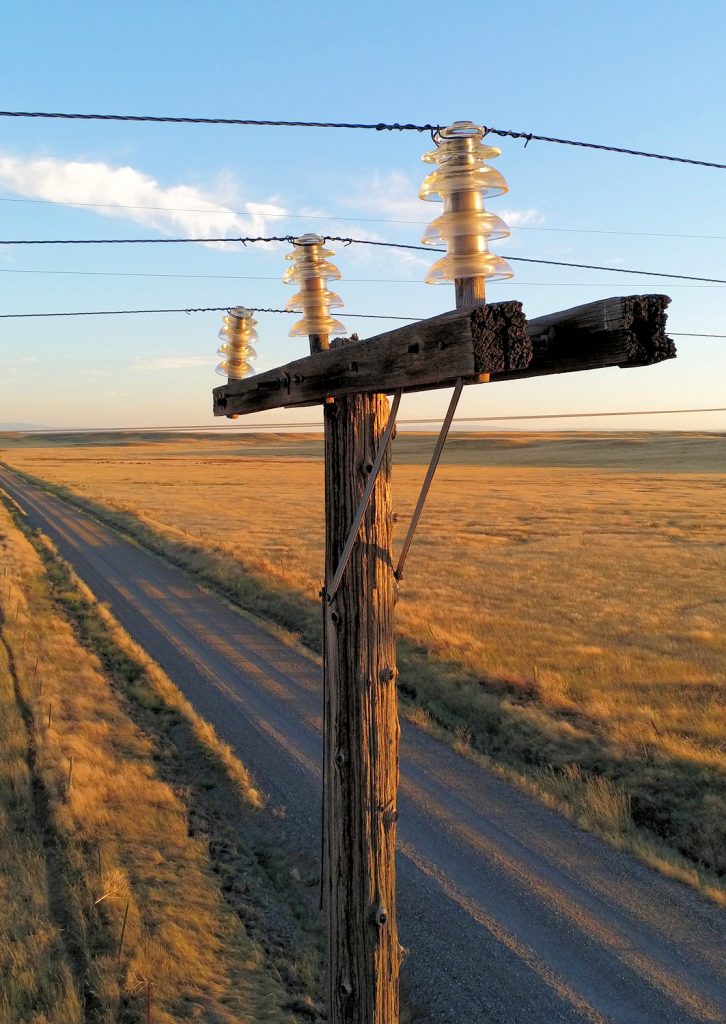
Wait… You collect what again? And why?
Yes, for the last ~34 years or so, I’ve collected old communications and power insulators. You know, those glass or porcelain things mounted on poles that keep the wires from touching anything (like the pole itself) that would lead to the electricity shorting out to ground.
As for the why part… Well, I’ve been fascinated with both electricity and history my entire life. I took up electrical engineering for my education / career because the pay is better, but my dream job is probably somewhere between historian, writer, and museum curator.
The story of the last 200 years of industrial progress is fundamentally electrical. At the dawn of the 19th century, the fundamentals of electricity were just starting to be understood as Volta built his first “pile”, or battery. Twenty years later, Hans Christian Oersted figured out there was a relationship between electric current and magnetism, and within a decade clever men like like Charles Wheatstone and William Cooke figured out how to make a workable communication system out of that concept with the electromagnetic telegraph. In 1837 the first commercial telegraph line opened for service between Euston and Camden Town in the UK, and with it the need for insulators to hold up the wires was born. Telegraph fever quickly spread across the industrialized nations of the world. By 1844, the Samuel Morse sent the US’s first telegraph message from Washington to Baltimore with the immortal words, “What hath God wrought?”
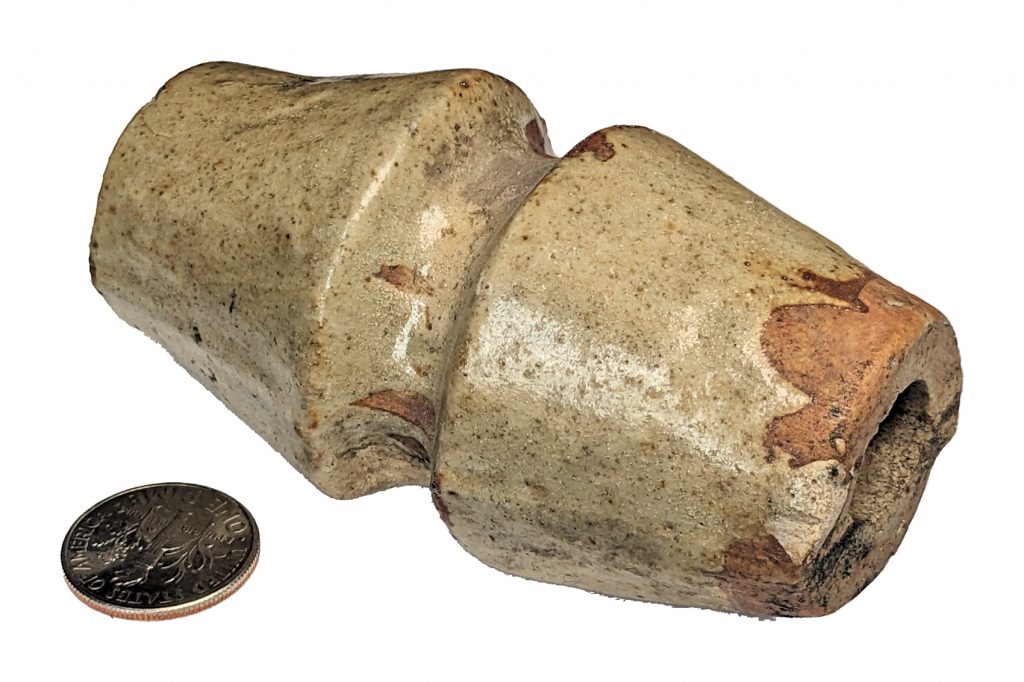
These small, somewhat delicate artifacts were “in the room where it happened” – to borrow a song title from Lin-Manuel Miranda. They not only represent the birth and growth of a completely new branch of science and industry that has made our modern world possible, but they were literally there, witnesses to history. Sitting on my desk in front of me is a threadless insulator used on the Union Pacific’s original transcontinental line, and it almost certainly saw the famous message of Dot, Dot, Dot, Done. go flying past as electrical pulses at nearly the speed of light that day in May 1869. In the other room is an original crossarm from the Central Pacific that witnessed the same message hundreds of miles west in the Nevada desert.
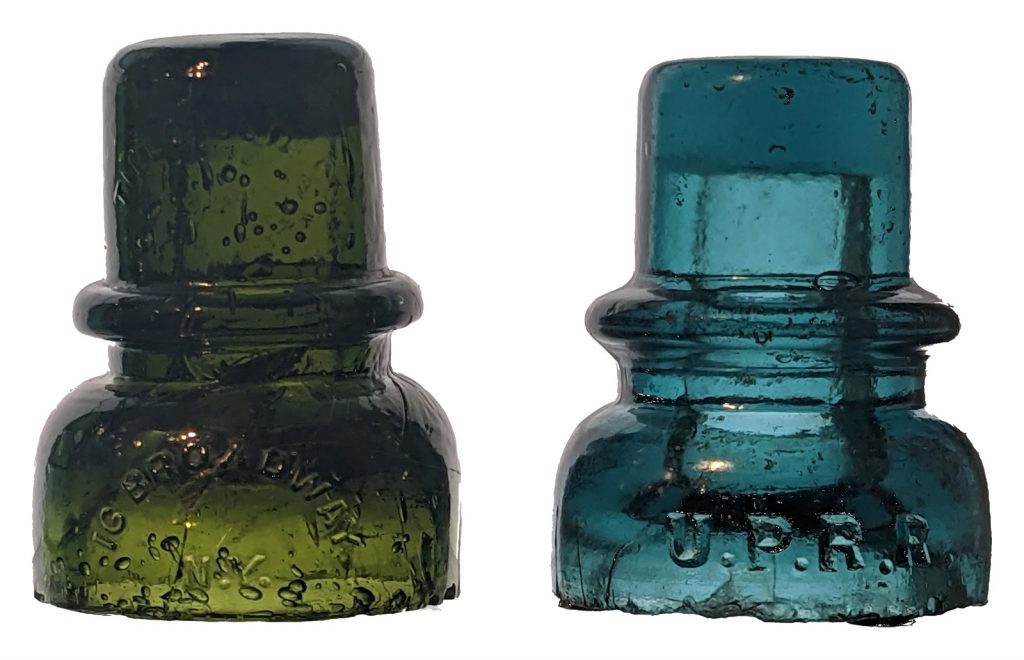
Elsewhere in the collection are insulators that saw messages go flying by during the US Civil War, both on the Confederate and Union sides, and looking at their construction tells us much about the warring parties. The Union insulators are high quality and well made, typical of the factories, industry, and knowledge of the North. The Confederate insulators are crude and makeshift, clearly produced by a society with no advanced (for the era) production capabilities. But regardless of the construction or political alignment, they were there at one of America’s darkest hours, and they represented a technological leap forward as the US Civil War was really the introduction of telegraphy as a tool of armies to coordinate and mobilize.
There are countless other stories that can be told. Pieces in the collection were early parts of Britain’s All Red Line, or the Indo-European Telegraph line, or from the Collins Overland Telegraph project to link North America with Europe via a line up through British Columbia and Alaska (then Russian America), over the Bering Strait, and then across Russia. Other pieces came from early high voltage power experiments, when engineers were pushing the limits of insulating technology to achieve longer, higher capacity lines.
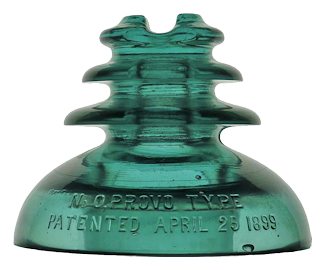
Over the next 40 years, the electrical industry exploded as it not only enabled telegraphy, but then telephony and power transmission. The quest for clearer-sounding, longer phone lines and ever-higher voltages for power lead to an era of experimentation and learning trying to figure out the best way to construct and insulate those lines. Hundreds of inventors created thousands of unique insulator designs, each designed to solve a niche problem. A few turned out to be good ideas, some turned out to be just interesting, a lot turned out to be terrible, but they lead to a great diversity of unique and colorful designs, each a unique example of a point in our technical history.
The Insulator Collecting Hobby
By the 1940s, the telecommunications industry (which used the bulk of glass insulators) had started to reach capacity limits as to how many calls could be handled on open wire lines. Poles traditionally could carry 4-5 pairs per crossarm. 1 pair, or 2 wires, was the minimum needed to carry a phone call, but through clever technology more than one call could be sent through a single pair – up to about 16 by the late 1930s, which for a standard 16-pair AT&T long lines route would give 256 simultaneous calls. But as phone service expanded and became cheaper, the sheer number of calls would still lead to congestion during peak hours. Plus, open wire lines were prone to damage due to weather and natural disasters, and required a constant team of linemen to keep them in top working order.
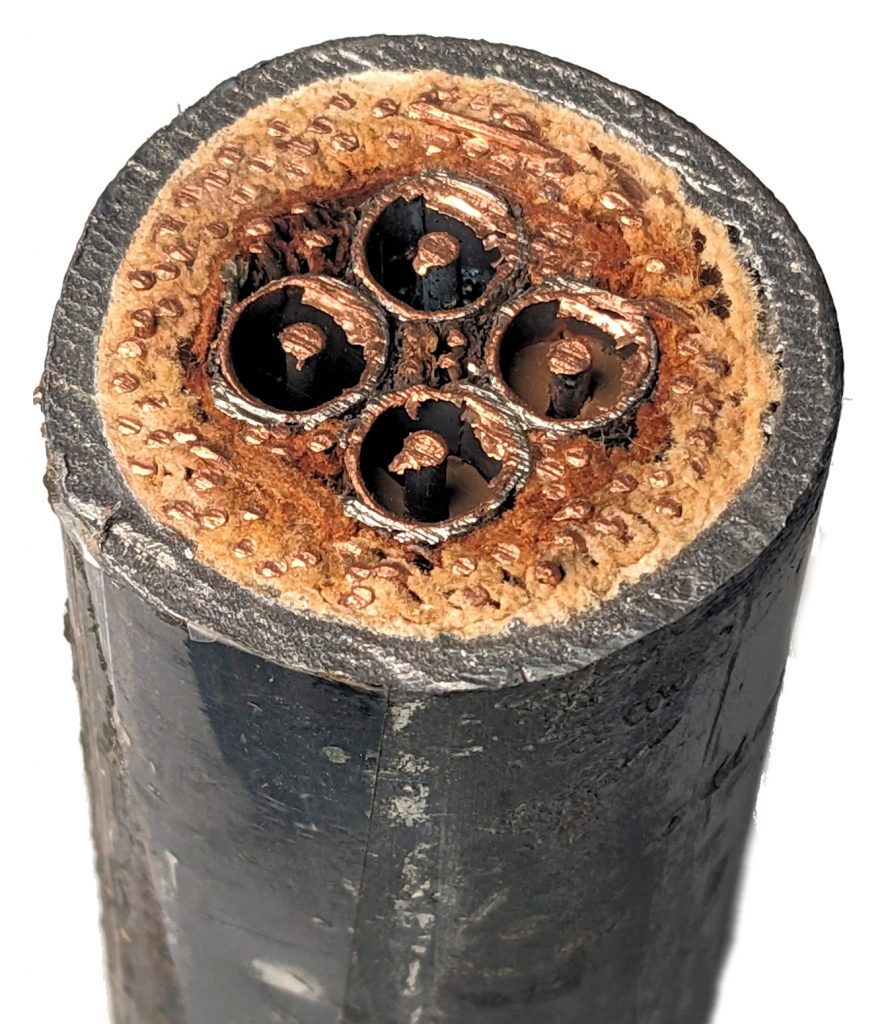
The answer was a number of different technologies. The first was simply to make the wires smaller, insulate them, and bundle them into a big waterproof cable that could be strung from poles or better yet, buried safely away from most things that could hurt them. Because the wires were smaller and individually insulated, many many more of them could be put into a single cable. The second was to make the wires able to handle a wider range of frequencies using coaxial cable so that even more calls (up to 480 each direction) could be packed into a single pair. Finally, in order to get rid of the wire entirely for long distance calls, AT&T started using a network of advanced radios and towers to create a transcontinental microwave network for carrying thousands of calls at once. The end of the telecommunications insulator was near.
As linemen started wrecking out obsolete lines, sometimes a colorful or unique piece would catch their eye and they’d put it in their truck to take home. Bottle collectors – already interested in old glass – would occasionally start picking them up. Given the fact that they were essentially industrial trash, most were free for the taking when lines came down and interest grew in the antique collecting community. The first attempts to organize as a distinct hobby came in the late 1960s, with articles about insulators in Old Bottle Exchange (OBX) magazine and then a dedicated insulator magazine – Crown Jewels of the Wire – published by Dora Harned that started in 1969. Swap meets grew into actual insulator shows, where collectors would get together to buy, sell, trade, and just show off their finds. There were a few attempts to put together a national organization specific to the hobby, but the one that finally stuck was the National Insulator Association (NIA), founded at the third national show in Hutchinson, KS, in 1973.
Fifty years later, the hobby is still around and vibrant. The NIA still sponsors a national show each year, and has taken the lead on promoting our hobby through their website, social media presence, and an exceptional full-color magazine that comes out every other month. Crown Jewels is still around, now on its fourth editor and known as “All Insulators: Crown Jewels of the Wire. Dozens of shows and swap meets happen all over the country every year, and there’s even a European show every other year.
My Collection
I’ve been collecting for about 35 years now. I started off like many of us – finding some glass on abandoned railroad lines and, strangely enough, at my grandmother’s house. I still have two of my grandmother’s insulators – a cracked clear CD 257 “Mickey Mouse” and this little Pinco piece to the right which I officially think of as my “first insulator”.
My parents found the Milhollands’ book Most About Glass Insulators somewhere, and then we discovered Crown Jewels Magazine, to which my mother kindly got me a subscription in August of 1986. Every issue, every book, everything got read cover-to-cover until the bindings wore out. I think I finally convinced my parents to let me go to a show in about 1989. Our annual summer vacations often included lots of stops at antique stores or downed poles, occasionally with an insulator show thrown in the middle somewhere. Until the end of high school, I was extremely active in the hobby.
Somewhere cars, girls (well, a girl in particular), college, and getting started as an adult eventually pushed the insulators to the background. I never got rid of anything, but it was years between me appearing at an insulator show, and and remembering to renew my NIA membership or Crown Jewels subscription became infrequent.
Then about 2016 the bug bit again. I’m not exactly sure what triggered it, but I’m pretty sure it had something to do with all the international travel I was doing for work and seeing all of the glass still up in the air in Europe. I’d always had a love of foreign pieces, encouraged by other early foreign collectors like Bernie Warren and Marilyn Albers. They were different, unique, and because the hobby was mainly (though not exclusively) a North American thing, there was still lots of new stuff to be discovered. I re-upped my memberships and started planning a new display room and how to get the collection out of storage.
Six months later in about March of 2017, with the help of a lot of Ikea IVAR shelf bits, plywood, stain, some backlit panels and a lot of small track spotlights, the collection room came together. I moved the collection in over the next few weeks, carefully cleaning, inventorying, and arranging each piece. The picture is a panorama shot of the room about six years later, in May 2023. I sized the collection room for what I thought would be about 10-12 years of growth. That was approximately how long – at the time – I figured I’d stay in the house before retiring. I may have underestimated – those empty shelves have dwindled quickly and insulators have started popping up all over the house.
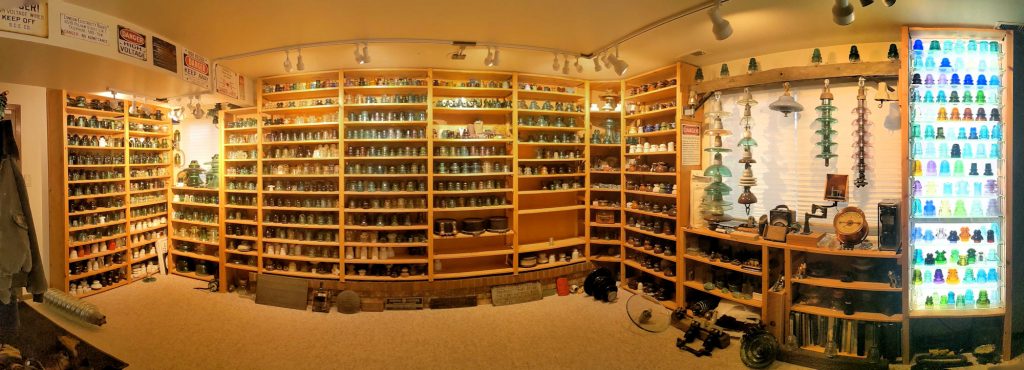
Learn More About Insulators and Collecting
The organized collecting hobby consists of around a couple thousand individuals worldwide, with probably a few thousand more casual collectors who have a few pieces but rarely engage with the formal hobby.
There’s two great websites that I recommend to help learn about the hobby: the National Insulator Association’s official website and Bill and Jill Meier’s Insulators.info. Both have a huge depth of information and you can spend hours exploring them.
A couple of fun things to get you started:
- The NIA’s Insulator Identification Gallery – Collectors have roughly divided insulators into North American and Worldwide, and then by porcelain or glass, and set up numbering systems to allow us to quickly identify, categorize, and communicate about what we have. If you want to figure out what kind of insulator you have or see the huge range of styles that exist, this is a great place to look.
- The NIA’s Online Publication List – The NIA has acquired the rights to many of the foundational books written about insulators and the hobby. You can download them for free and read a great deal about not only the insulators, but the history behind them.
- Back Issues of the NIA’s Drip Points Magazine – If you want to see what’s (almost) currently going on in the hobby, check out the archive of Drip Points, the NIA’s membership magazine. Everything from before 2 years ago is available online for free download. Want those issues that aren’t yet free for download? Join up!
- Finally, the Insulators.info Show List – There’s no better way to get to know the hobby than to show up at a show! Most are free for visitors and all welcome newcomers to the hobby. Find one in your area and come check out all the fun stuff that shows up.
Since everybody seems to ask it, let’s cover probably the most common question about insulators: What are they worth?
That’s actually an unbelievably complicated question. Answers range everywhere from “I’ll pay you to take buckets of them away” to north of $30,000 each. And no, I don’t have any of those $30k pieces. I have a healthy hobby budget, but it’s not that healthy. The exact value depends on rarity, appeal, and at the end of the day, how badly somebody wants it. Something like a clear Hemingray 42 was made by the tens of millions. Every antique store has a couple. But if you find one that has a large “MR” on it above the Hemingray embossing (still clear), now you’re looking at something that’s worth 600-1000 and there’s only a couple dozen known. As a rule, color sells. CD 162 Hemingray 19s come in a wide array of colors, from dull clears that were made by the millions to purples, ambers, cobalts and vibrant greens. The various ambers and cobalt blues aren’t that rare – there’s probably thousands of them in the hobby, but they still go for a few hundred in good shape. But they’re pretty and everybody seems to have at least a few, whether that’s what they specialize in or not. You can see my run of colors from purples to dark amber in the picture to the right above.
However, color isn’t always a sure bet of rarity. The CD 1050 spool-type insulators that come from Colombia are relatively common in various rich cobalt blues and vibrant purples. But if you find a clear or a green aqua piece? Those are rare.
Unusual shapes are popular, either because they’re visually appealing or rare, or both. Most of the truly oddball designs proved fragile or expensive to manufacture, or both, and consequently were only installed in extremely limited quantities. On the right is a photo of three popular oddballs from my collection – two glass “Harloe Claws” (a CD 206.5 on the left, and a CD 109.5 on the right) meant to save the linemen from needing to install tie wires to hold the line on the insulator (as the claws would grip it) and a CD 181 “Pluto”, meant to hold up the heavy DC power cables through the underground ducts that powered the 1893 Chicago World’s Fair. All oddball designs that did not prove popular, and in the case of the Harloes proved to be fragile as well. Probably less than 100 of each survive today, and most of the Harloes have at least 1-2 broken fingers.
Then again some the rarest pieces probably wouldn’t cause the average person to look twice, and only appeal to a certain subset of collectors. Here’s a tar-coated wooden telegraph insulator made by the Kenosha Insulator Company in the mid-1870s. Due to its construction from wood, general non-descript ugliness, and the fact they were used outside in the midwest, only three known complete examples survive today. I found one of them as a kid in Iowa. But, despite their rarity, they probably wouldn’t go for as much money as a Harloe claw in good condition because their appeal is significantly less to the average collector.
As a general rule, glass is going to go for more than porcelain, but good color or unusual designs will bump up the value in both. Stuff from outside North America, where the bulk of collectors live, is going to have some lower bound just based on the fact that acquiring it and shipping it over here isn’t cheap. Even if it’s common as dirt in its home country, it’s still going to be at least $20 to get it here if shipped in bulk with its friends.
And that boring modern polymer insulator stuff? I’m sure somebody will collect it, but that somebody is not likely to be me. That firmly falls in the value of “I’ll pay you so I don’t have to haul it off…”
I Buy Insulators! Have Insulators and Want to Sell?
This page wouldn’t be complete if I didn’t mention I’m always looking for good insulators, either for my collection or for trade / resale with other collectors. If you think you’ve got something unique, or if you have a pile that you discovered, please get in contact and send pictures by emailing maverick@drgw.net. I’d be happy to evaluate them and possibly make an offer.
